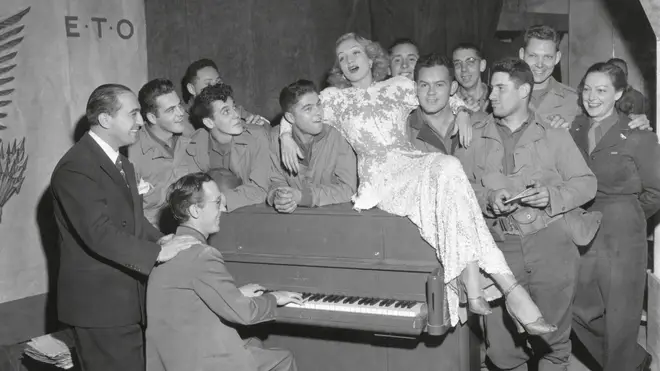On Air Now
Early Breakfast with Lucy Coward 4am - 6:30am
5 May 2022, 16:22 | Updated: 5 May 2022, 17:07

Called the Victory Vertical or G.I. Steinways, pianos were dropped into battlefields during World War II to provide some recreation for the American troops.
Steinway and Sons is a German-American piano company, which was founded in 1853. The high-profile piano company annually dominates the high-end grand piano market, and has won several awards for its multiple patents and musical instrument designs.
But one design, created during World War II was more... aerodynamic than previous pianistic models.
Around 5,000 special models of piano called the ‘Victory Vertical’ or ‘G.I. Steinways’ were made during the Second World War; a small piano designed to be carried on ships or dropped by parachute from an airplane to bring music to the soldiers on the battlefield.
The first Victory Vertical parachuted into battle in 1942 and around 3,000 pianos were sent into military service during the war, while the rest went to churches and schools.
Read more: Why musicians have all the skills to be the best spies
#steinway
— Regulus (@CucumberLenin) April 10, 2020
To boost morale, Steinway produced lightweight simple pianos in sturdy drawers during World War II - this allowed them to be parachuted. pic.twitter.com/qRy1vwHOsj
Morbidly, Steinway had been producing coffins in their American factory during the war due to the government restrictions on iron, copper, brass, and other raw materials, but they received special permission to build around 3,000 Victory Verticals for the American troops.
Being a German-American company, Steinway also had a factory in Hamburg, Germany. With factories in countries which were on either side of the war, it was inevitable their buildings could accidentally become a target, and during an air raid over Hamburg, several Allied bombs hit the factory and nearly destroyed it.
An American initiative in 1948 called the Marshall Plan helped to restore the Hamburg factory to its former glory.
Listen to our playlist of calm piano music, exclusively on Global Player
All production, where metals were used, was suspended for the manufacture of ammunition. In order to exist, many manufacturers of musical instruments temporarily made wood products, from toys to coffins. Steinway & Sons also produced the necessary parts for the front at that time pic.twitter.com/d8BRpnAKPF
— Regulus (@CucumberLenin) April 10, 2020
Music was used as an escape for American troops abroad, and the government looked to the pianos as a way to help soldiers remember what they were fighting for. The President of Steinway and Sons had four sons in the military at the time of the creation of the Victory Verticals, so had close connections with the frontlines.
Steinway had a letter sent from a Private Kenneth Kranes, stationed in North Africa in 1943, to his mother back in New York.
In the letter he recounts, “Two nights past we received welcome entertainment when a jeep pulling a small wagon came to camp. The wagon contained a light system and a Steinway piano. It is smaller and painted olive green, just like the jeep.
“We all got a kick out of it and sure had fun after meals when we gathered around the pianna [sic] to sing. I slept smiling and even today am humming a few of the songs we sang.”
Sadly the private was killed in battle a week later.
Read more: Poignant footage of man playing piano amid rubble after losing his home in Kentucky tornado
So appeared Victory Verticals, whose weight was about 200 kg and a length of 1 meter. V. V. was treated with a special insect repellent and coated with a protect composition to it from moisture. The main is that there was very little metal: about a 10‰ of an ordinary piano. pic.twitter.com/UuzDqyZFoL
— Regulus (@CucumberLenin) April 10, 2020
The Victory Verticals were light enough to be able to be lifted by four men, holding specially placed handles under the keybed, which made them easily transportable, and all the instruments came with tuning equipment and instructions. The pianos also didn’t have legs like most upright pianos, as otherwise they wouldn’t have been able to withstand an airdrop.
Other features of the rugged but durable pianos included water-resistant glue, anti-insect treatments, keys covered with celluloid (instead of ivory), and bass strings which were covered in soft iron instead of the traditional copper.
Due to restrictions, they were also designed using a tenth of the metal used to make a normal piano.
While most pianos come in a black or dark wood finish, in order to camouflage them into landscapes, the pianos were painted in olive green, blue, and grey.
Read more: A rediscovered wartime waltz has been performed for the first time

Classical pianist Alisdair Hogarth and tenor Liam Bonthrone perform 'Dancing With a Memory'
These pianos brought joy and music to a place where both are usually silenced. And 73 years after the war ended, Steinway are still helping bring wartime music to life.
In 2018, Steve Castle discovered a piece of music written by his grandfather during the war, he shared the story on Twitter, and Classic FM helped him bring it to life with a performance at Steinway Hall in London (watch above).